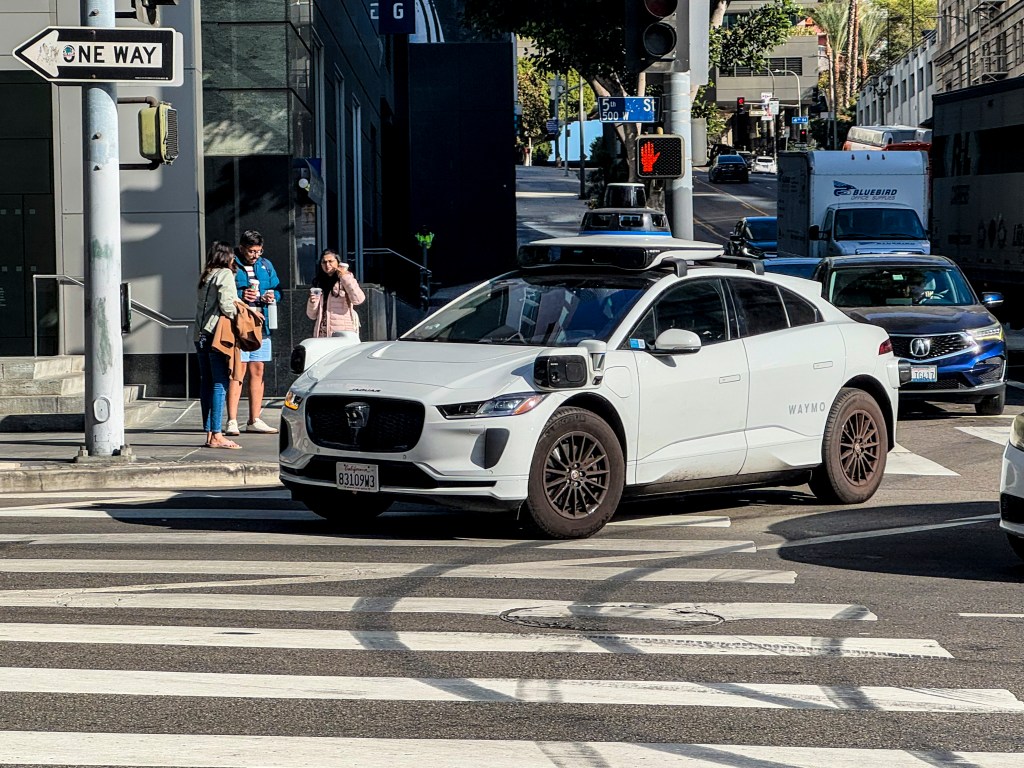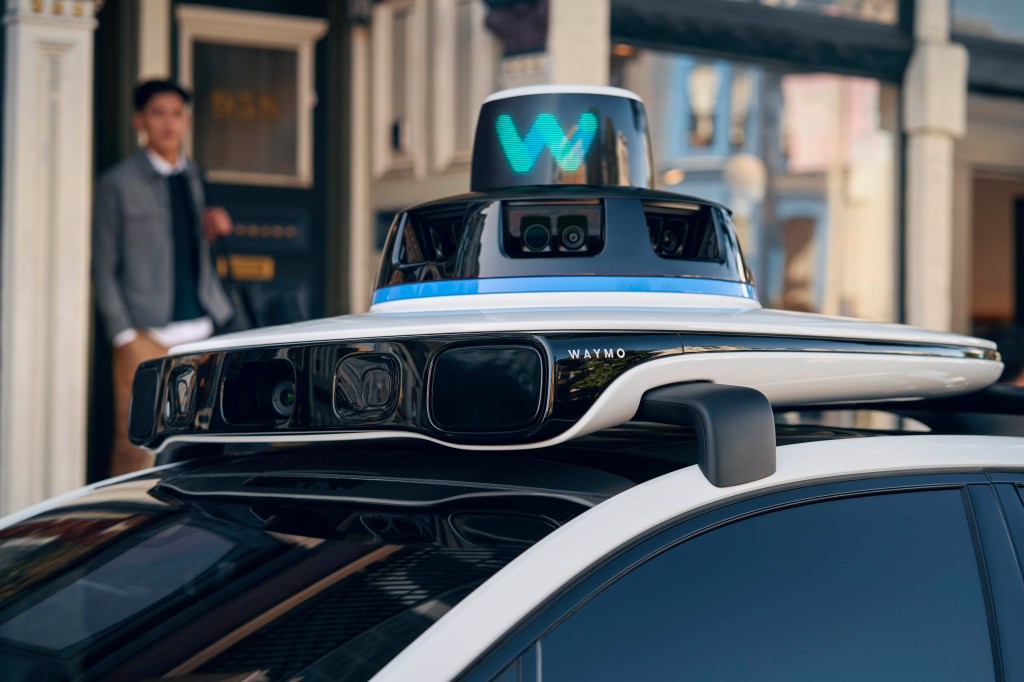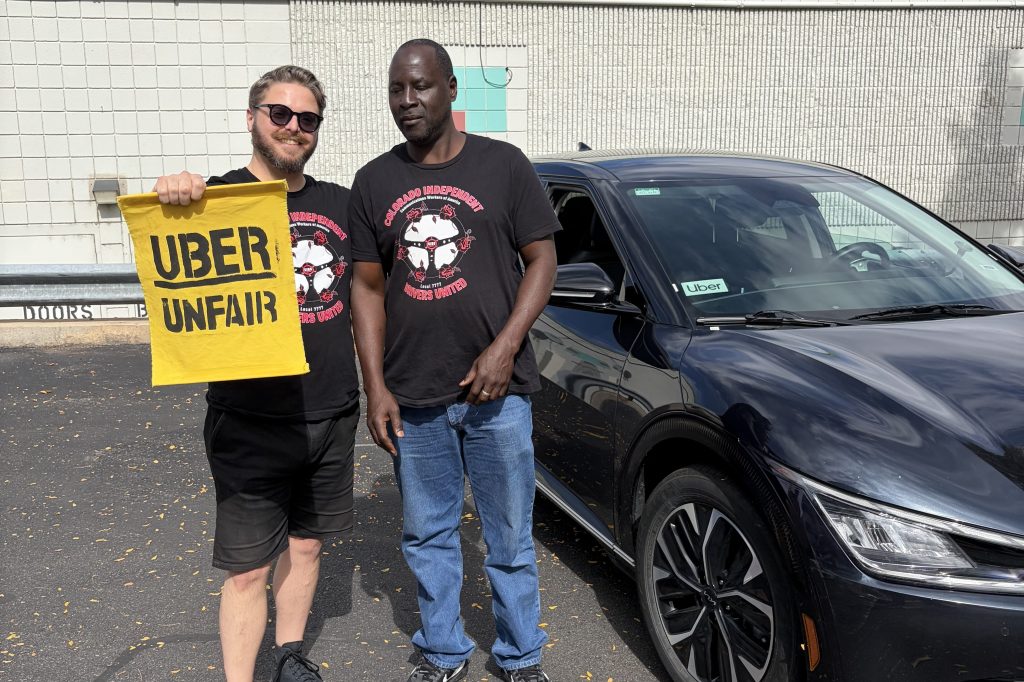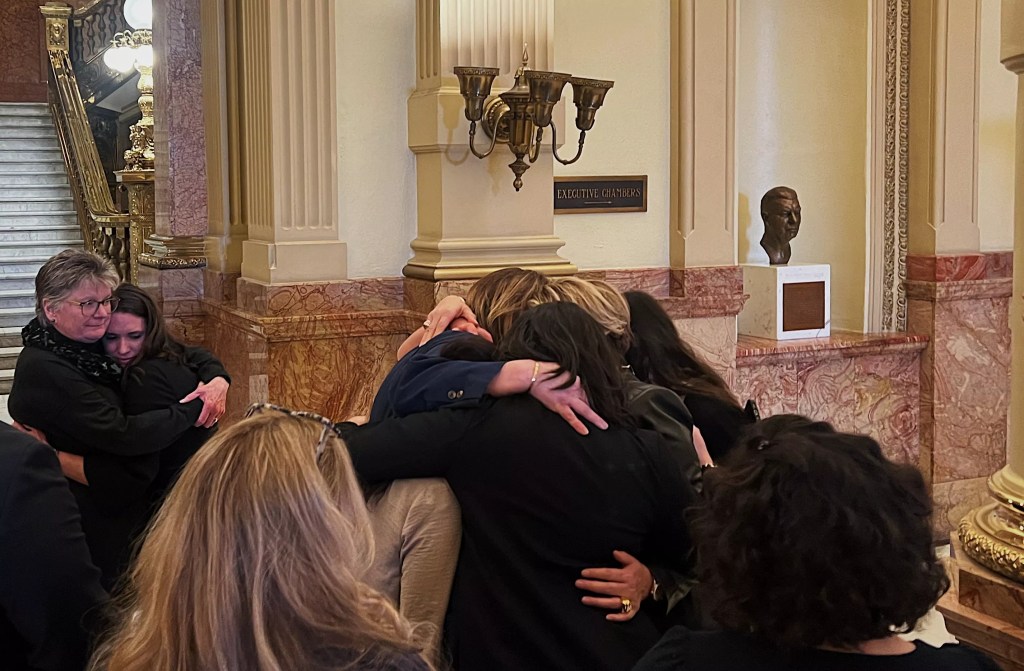
Bradley Hansen

Audio By Carbonatix
A new type of vehicle has emerged on Denver’s roads over the last month: a dozen white electric Jaguars equipped with cameras and sensors that enable the cars to drive without anyone behind the wheel.
They’re part of the latest expansion of Waymo, the world’s first autonomous ride-hailing service. The AI-powered vehicles are currently mapping the Mile High City (under the supervision of human employees in the driver’s seat), and are expected to be open to riders by early next year.
The robotaxi service has spread nationwide, from San Francisco to New York City. In October, it was named one of the best inventions of 2025 by Time magazine, which lauded Waymo as a potential solution to traffic fatalities. Unlike people, the Waymo Driver doesn’t get distracted by a cell phone or fall asleep behind the wheel. It doesn’t lash out from road rage, drive drunk or force unwanted conversation.
The future has arrived in Denver…but is it here to stay?
We’re thankful for you. Are you thankful for us?
We feel thankful for our staff and for the privilege of fulfilling our mission to be an unparalleled source of information and insight in Denver. We’re aiming to raise $50,000 by December 31, so we can continue covering what matters most to this community.
Help us continue giving back to Denver.
Waymo launched its fully driverless service in Phoenix in 2020. Now, the self-driving cabs also operate in Los Angeles, San Francisco, Atlanta and Austin. In addition to Denver, the company plans to begin autonomous rides in Dallas, Nashville, Seattle and Washington, D.C., in 2026. Waymo cars and software are also being tested in several other cities, including New York City and Las Vegas.
“Denver’s position as one of the top ride-hailing markets in the U.S. and Colorado’s welcoming regulatory environment make it the perfect place to bring our service,” says Waymo spokesperson Sandy Karp, calling the vehicles “a safe, reliable, and magical way to get around.”
But the rollouts haven’t always gone smoothly. Waymo recalled over 2,300 self-driving vehicles in 2024 and 2025 following collisions with road barriers, a utility pole and a towed pickup truck. In San Francisco, Waymo taxis received 589 parking tickets in 2024. The National Highway Traffic Safety Administration launched an investigation into Waymo in 2024 due to such behavior, but closed the probe in July without taking further action.
The cyber-cabs made headlines after anti-ICE protesters set the vehicles on fire in L.A., and when dozens of confused Waymo cars disturbed residents by honking at each other in a self-induced parking-lot traffic jam. And, of course, when passengers began taking advantage of the driver-free system to have sex in the back seat.
Despite this, Waymo is seen by many as the answer to improving road safety. A peer-reviewed study by Waymo found that its self-driving cars had a significantly lower crash rate than human drivers. According to the company, each mishap has led to software updates, teaching the Waymo Driver how to better respond in the future. The company calls its system “the world’s most experienced driver,” having traveled over 100 million fully autonomous miles on public roads.
Local officials, including Governor Jared Polis and Mayor Mike Johnston, have embraced Waymo for this reason.
“More choices about how to get where you want to go is a good thing,” Polis says. “Colorado is a national leader in innovation, and we embrace the ways new technology, such as autonomous vehicles, can increase transportation options, improve road safety and, in the case of Waymo, reduce emissions and pollution by getting more electric vehicles on the road.”
But there is still a long way to go before Denver residents can actually use the new robot chauffeurs — and plenty of roadblocks to overcome.
Winter Driving
Waymo’s safety results are undeniably impressive. Compared to human drivers, the autonomous vehicles had 81 percent fewer airbag-deploying crashes, 85 percent fewer crashes with serious injuries, 96 percent fewer injury crashes at intersections, and 92 percent fewer crashes that involve injuries to pedestrians across 56.7 million miles driven through the end of January 2025.
However, those numbers come from the vehicles’ operations in San Francisco, Los Angeles, Phoenix and Austin. Driving in the mostly dry, warm weather of those cities is very different than driving in the snow, rain and hail of Denver.
Karp says Waymo has tested its vehicles in over fifteen states across the country, including in snowy conditions in Michigan, upstate New York and the Sierra Nevada mountain range. But the company isn’t fully operational in any cold-weather city.
“These focused testing visits allow us to gather experience and learnings that we apply across all the cities where we serve and plan to operate,” Karp notes.
Waymo Driver works by first mapping the city in which it will operate, including lane markers, stop signs and crosswalks. While driving, the vehicles use 360-degree cameras, radar sensors and lidar sensors to decipher their surroundings. The AI system employs this real-time information and past experience to plan its route and to anticipate and respond to the actions of drivers, cyclists and pedestrians.
Snow, ice and slush can stick to sensor housings and “blind or degrade performance,” says Frances Zhu, a professor at the Colorado School of Mines who researches how autonomous systems perceive their environment and make decisions in uncertain, complex and harsh conditions.

P_Wei/Getty Images
According to a Waymo spokesperson, the company “implemented preventive measures to each of our sensors to maintain a clean view of its surroundings.”
“It isn’t so much the snow coming down, it’s that the roads completely change when there’s snow,” Waymo co-CEO Tekedra Mawakana said during the Atlantic Festival in September. “There’s a human understanding of whether or not, or how you’re going to navigate the situation. …It just takes more experience. Right? This is machine learning and AI. And so, the driver just needs more cycles with those.”
When roads and lane markings are covered with snow, autonomous vehicles must rely on maps and surrounding vehicles, Zhu explains. They struggle with inconsistent plowing and partially snow-covered roads, as AI has difficulty detecting subtle cues that human drivers use, such as curb edges and snowbanks, she adds.
One of the biggest winter challenges will be black ice. The vehicles can detect wheel slip and reduce speed accordingly, but black ice is “nearly invisible even to advanced sensors,” Zhu notes.
“Humans often anticipate icy spots based on experience; shadows, bridges,” she says. “Current AVs don’t have that same predictive intuition, so response may be reactive rather than anticipatory.
“It’s impossible to anticipate all of the corner cases driving on a winter road, so there will inevitably be situations in which the Waymo algorithm has to base decisions unfounded on human driving data or extrapolate,” Zhu adds. “Based on Waymo’s rollout and testing in other places, they err on the side of caution. So, you may see more Waymo cars pulled off to the side of the road or highway, which may have different problems if you essentially have a lot of timid drivers on the road.”
In addition to weather, Waymo will need to navigate the frequent construction and closures on Denver’s roads. That task has repeatedly confused the robots in San Francisco, reportedly leading Waymo vehicles to stall out at parade street closures and onramps with closed lanes. The robotaxis have also attracted attention for coming to a standstill in a Chick-fil-A drive-thru and while making a U-turn in front of a motorcade escorting then-Vice President Kamala Harris.

Waymo
Regardless, professor Zhu says she plans to ride in the Waymo taxis when they’re available in Denver. She currently drives a Tesla and uses its self-driving feature; she perceives Waymo as the safer option, noting that its vehicles have more sensors than Tesla’s.
“There will always be some absolute risk to trying something new like self-driving cars in a winter weather environment, but the more interesting question is whether these Waymo cars will perform better than humans,” Zhu says.
There have only been two fatal collisions involving Waymo, though the autonomous vehicles were not considered at fault. In both incidents, the Waymos were empty and struck from behind by human drivers: one while in standstill traffic and the other while slowing to turn into a parking lot.
Human Rivals
Even if autonomous vehicles can drive as well as humans do, local rideshare workers argue that driving is only part of the job.
“There’s a customer service part to it. There are so many human touches,” says Steve Lustig, a Denver rideshare driver of six years and an organizer with the Colorado Independent Drivers Union.
“A robot can’t recommend a restaurant. Visitors in town ask, ‘What’s there to do in Denver, what can a local recommend?’ The robots don’t have that touch of humanity and that ear to the community,” Lustig adds. “The experience is very dystopian. They’ve totally removed all of the humanity from it.”
The union has been pushing against Waymo coming to Denver, describing it as “a serious job security threat,” says executive director Kayla Frawley.
Rideshare driver Kareem Sawadogo says he often performs physical tasks for his riders that Waymo can’t do, such as loading their luggage or assisting wheelchair users into the vehicle.
“Waymo won’t even open the door for them,” says Sawadogo, who is also an organizer with the Colorado Independent Drivers Union.

Colorado Independent Drivers Union
Sawadogo questions what would happen if a passenger has a medical emergency in an autonomous vehicle, or passes out from having too much to drink. He says he frequently has to call emergency services for drunk, unconscious passengers; at times, he says, he has knocked on the door of their home address in order to get them assistance without involving the police.
That’s a courtesy that a cyber-cab couldn’t extend. When Waymo passengers do not exit the vehicle at their destination, a remote human employee will assess the situation using cameras inside the car, according to a report in the San Francisco Chronicle. An employee will then use the car’s customer service interface to try to communicate with the passenger, and will contact emergency services if they don’t respond.
For some riders, avoiding human interaction is the goal, and it’s not always just about solitude. Colorado has a troubling history of rideshare drivers assaulting passengers.
In March, Lyft driver John Pastor-Mendoza was sentenced to 290 years in prison for kidnapping and/or sexually assaulting twelve women, targeting intoxicated passengers seeking rides home in Denver. In 2024, Lyft driver Shengfu Wu was sentenced to nine years in prison for raping a thirteen-year-old passenger in Aurora. That same year, Uber driver Nesrelah Bedru Kemal was arrested and charged with sexually assaulting a passenger in Denver.
The issue was brought to the forefront in January, when State Representative Jenny Willford said that she was sexually assaulted by her Lyft driver outside of her Adams County home in 2024.
Willford sponsored a bill intended to improve safety in rideshares, in part requiring more frequent background checks and cracking down on authorized account sharing by drivers. The bill, HB25-1291, passed the legislature but was vetoed by Polis in May after Uber threatened to cease operations in Colorado if the governor signed the policy into law.
Despite her harrowing experience with rideshares, Willford says she does not plan to use Waymo when it opens to the public.
“I don’t see driverless vehicles as a solution to the safety issues I tried to address with HB25-1291, and I don’t agree with eliminating drivers completely,” Willford says. “Human judgment and responsibility will always matter when it comes to keeping people safe on our roads. While I’m all for innovation, driverless vehicles like Waymo raise serious questions about safety, transparency and accountability.”

Hannah Metzger
The robotaxis have proven successful in other cities, however. Waymo’s prices are comparable to those of Uber and Lyft. In June, YipitData reported that Waymo had surpassed Lyft’s market share in San Francisco. In Nashville, Austin and Atlanta, Uber and Lyft have partnered with Waymo to provide its driverless vehicles via their apps.
That is a concern for the thousands of rideshare drivers who operate in Denver. Drivers Cooperative Colorado, a local driver-owned rideshare company, says it wishes state officials would support their business as much as they are supporting Waymo’s expansion into the capital city.
“As Colorado leaders embrace Waymo driverless cars with open arms, we wish they would also be sensitive to all the local rideshare jobs that Waymo’s robot taxis will replace,” the cooperative says in a statement. “Every driverless car on the road doesn’t just replace a vehicle — it replaces the livelihood of a local rideshare driver, hollowing out one of the most accessible sources of working-class jobs.”
Sawadogo says he has driven for Uber, Lyft and the co-op for ten years, and first started as taxi driver in 1998. He fears what will happen to his livelihood if Waymo eliminates the demand for rideshare drivers in Denver.
“If they take my driving ability, they take everything,” Sawadogo says. “I really enjoy being a rideshare driver. I like to meet new people, a lot of friends and being part of my community. I really love it. If Waymo comes, I’m going to lose all of that.”
What’s Next?
They say you can’t stop progress, but that doesn’t mean you can’t try.
According to Sawadogo, the Colorado Independent Drivers Union plans to ask state legislators to ban autonomous cabs from operating in Colorado for “at least ten years.”
“The techno-oligarchs like Elon Musk and Dara Khosrowshahi want to automate us out of jobs so that they can make more money,” Lustig says. “In a decade, Uber drivers will be as relevant as a horse and buggy driver. That’s what they want to make us.”
Under a state law passed in 2017, highly autonomous driving systems without a human driver are authorized to operate in Colorado if they can meet all applicable state and federal laws. Willford suggests that she is open to further regulations on the technology.
“This is a whole new frontier that will come with its own host of issues, and I believe the state has a clear role to play in providing oversight and setting guardrails to protect the public,” the state rep says.
Any proposed legislation may face an uphill battle, though, as Waymo enjoys the vocal support of Governor Polis, who has the power to sign or veto any policy that comes from the legislature.
“I am confident that Waymo’s expansion will not replace local rideshare drivers who are also an important part of our economy and transportation network, but simply increase options for Coloradans,” Polis says.
A spokesperson for Mayor Johnston echoes this sentiment: “Waymo is but one of many options Denverites will have to choose from when it comes to transportation, and we will continue to support rideshare drivers in their ability to make a living in Denver.”
According to Karp, Waymo’s autonomous vehicles will begin operating downtown in 2026 and gradually expand across the Denver area. The company plans to offer airport transportation sometime in the future, too.
“We’re just getting started in Denver, but based on our experience in other cities, the Waymo Driver is adapting well to new places,” Karp says.
But will a new market adapt? California residents unhappy with Waymo have resorted to bullying the vehicles, reportedly jamming traffic cones onto the hoods, parking cars to surround them or simply standing in the road to block their path. Waymo sued two Bay Area residents in 2024, accusing one of slashing tires on nineteen of its vehicles, and the other of intentionally striking a Waymo vehicle twice with his Tesla.
Will Denver revolt against the machines or embrace the cyborg chauffeurs? Either way, as Sawadogo puts it, “robots won’t complain.”